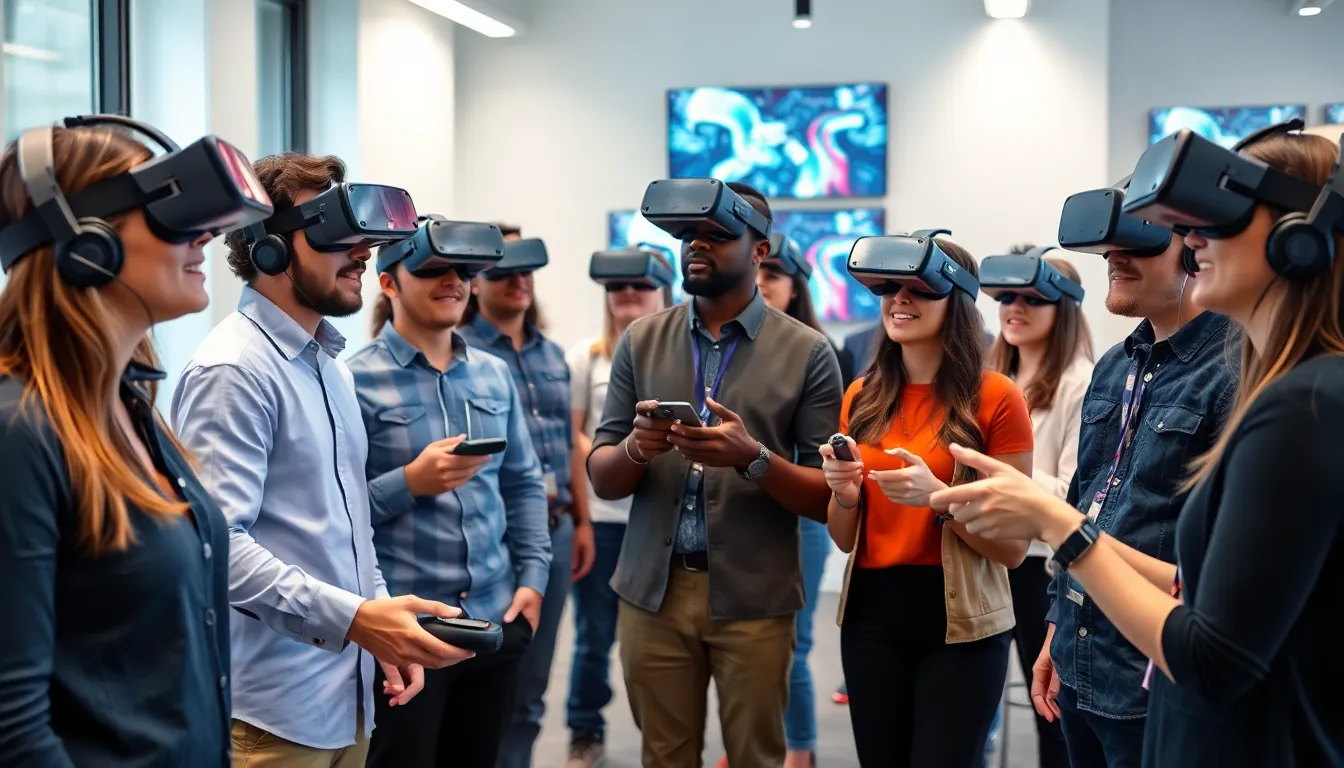In a world where reality can sometimes feel a bit too mundane, augmented and virtual reality apps are here to spice things up. Imagine stepping into a digital realm where the only limit is your imagination. AR and VR aren’t just for gamers anymore; they’re transforming industries from education to healthcare, making learning and training more immersive than ever.
ar/vr app development
AR and VR app development emphasizes creating interactive environments that enhance user experience. Developers use specialized tools and frameworks to build immersive applications for various platforms, including smartphones, tablets, and dedicated VR headsets. Popular AR development platforms include ARKit for iOS and ARCore for Android, while Unity and Unreal Engine serve as essential game engines for VR experiences.
Designing for AR involves overlaying digital assets onto the real world, requiring precise spatial awareness. VR development focuses on creating fully immersive simulations that transport users to different environments. Developers must consider factors such as user interface design and comfort to ensure a seamless experience.
Testing AR and VR applications is crucial, with developers conducting extensive user feedback sessions and beta testing phases. Identifying bugs and refining interactions significantly enhances the final product. Collaboration with artists and sound designers plays a vital role in producing compelling visuals and audio that enrich the overall experience.
Market research indicates a significant rise in demand for AR and VR applications across industries, particularly in retail, healthcare, and education. Statistics show a projected growth of the AR/VR market from $12 billion in 2020 to $300 billion by 2024. This surge signifies a strong interest in tailoring applications that cater to specific needs.
Adoption of AR and VR technologies requires staying updated on trends and tools, ensuring developers can leverage the latest advancements. By investing in skills and resources, teams can create innovative experiences that push the boundaries of technology.
Key Technologies in AR/VR

AR and VR app development relies on a range of advanced technologies that enhance user engagement and interactivity. Understanding these technologies is critical for developers aiming to create impactful experiences.
Augmented Reality Technologies
AR technologies often utilize computer vision and depth tracking. Through ARKit on iOS, developers create immersive overlays that interact naturally with the real world. ARCore serves a similar purpose on Android, enabling developers to build compelling experiences. Spatial mapping enhances the user experience by allowing digital content to anchor to real environments. Sensors in mobile devices add another layer of interaction, providing real-time feedback. Drones play a significant role, capturing real-world imagery for integration into AR applications. Unity and Unreal Engine support these technologies, offering tools that streamline AR content creation.
Virtual Reality Technologies
VR technologies primarily involve head-mounted displays and motion tracking sensors. Headsets like Oculus Rift and HTC Vive create fully immersive environments that transport users to different realities. With hand controllers, users can interact with virtual worlds in real-time. Game engines such as Unity and Unreal Engine provide the required framework for developing VR applications. 3D audio technology enhances realism, making the experience more engaging. Additionally, haptics technology improves tactile feedback, allowing users to feel sensations within virtual environments. Networking capabilities support multiplayer experiences, ensuring users can connect with others in shared virtual spaces.
Development Process for AR/VR Apps
The development process for AR and VR apps focuses on multiple stages that ensure user interaction and engagement. Each stage plays a crucial role in creating effective applications.
Conceptualization and Design
Conceptualization begins with defining user needs and app objectives. Conducting brainstorming sessions can help generate innovative ideas tailored to the target audience. Designers proceed with wireframes and prototypes, focusing on navigation, interaction, and overall user experience. Visual elements must align with both AR and VR principles, ensuring a seamless blend of digital and physical worlds. Selecting the right tools is vital; ARKit and ARCore facilitate augmented experiences, while Unity and Unreal Engine structure immersive VR environments. Keeping user feedback in mind during this phase guides the design to meet expectations efficiently.
Implementation and Testing
Implementation necessitates coding and integrating various components like graphics, sound, and interactive features. Developers utilize established frameworks to streamline this process efficiently. Testing follows implementation, prioritizing user feedback through various methods including beta tests and usability evaluations. Exploring user interactions helps refine functionalities and identify potential issues. Effective testing verifies app performance across different devices, ensuring compatibility and accessibility. Analyzing data collected during testing informs necessary revisions and adjustments that enhance the final product. Continuous iteration fosters a responsive development cycle that aligns closely with user needs.
Challenges in AR/VR App Development
AR and VR app development presents numerous challenges that developers must navigate effectively to create successful applications.
Technical Challenges
Technical challenges frequently hinder progress in AR and VR app development. High-performance hardware requirements often limit the accessibility of these technologies. Developers must optimize applications for varying device capabilities, ensuring smooth performance on multiple platforms. Additionally, latency issues can disrupt the immersive experience, demanding precise optimization to maintain engagement. Complexities arise from limited bandwidth, affecting data transmission between devices. Additionally, integrating various sensors and technologies requires careful calibration to ensure accurate interactions. Mixed reality demands precise spatial awareness, adding another layer of complexity in development.
User Experience Challenges
User experience challenges serve as pivotal factors in AR and VR app development. Realistic and intuitive interactions remain essential for maintaining user engagement. Developers must design interfaces that prioritize ease of use while accommodating diverse demographics. Motion sickness can impact user enjoyment, prompting developers to optimize for comfort during interactions. Furthermore, the onboarding process must clearly explain app functionality to new users, ensuring smooth entry into the experience. Feedback from users plays a significant role, so ongoing testing and iterations are crucial to refine experiences. Balancing these user experience elements significantly influences the overall success of AR and VR applications.
Future Trends in AR/VR App Development
Emerging trends in AR and VR app development highlight the increasing integration of artificial intelligence and machine learning. These technologies enable personalized experiences, adapting content in real-time based on user interactions and preferences. As a result, developers can create more engaging and tailored applications.
Enhanced collaboration tools also shape the future landscape. Remote teamwork applications utilize AR and VR to facilitate interactive meetings in virtual environments. This innovation allows users to interact naturally, simulating physical presence despite geographical distances.
Furthermore, the expansion of 5G networks accelerates the potential of AR and VR. Higher bandwidth enables smoother streaming of rich media, reducing latency issues that often impede performance. Consequently, developers can craft more complex, immersive experiences without compromising quality.
In addition, cross-platform integration becomes increasingly important. Applications designed for multiple devices—such as smartphones, tablets, and VR headsets—enhance accessibility, allowing broader user engagement. Seamless experiences across devices ensure users remain connected to the content regardless of their platform choice.
Moreover, gamification continues to influence various sectors beyond entertainment. Education and training applications increasingly incorporate game elements, fostering motivation and participation among users. This trend aligns with the growing recognition of immersive learning and its effectiveness.
Sustainability considerations also rise in importance within app development. Developers seek to minimize environmental impact through energy-efficient designs and sustainable practices. Initiatives that prioritize eco-friendly solutions are becoming standard, attracting environmentally conscious consumers.
Overall, continual advancement in AR and VR technologies leads to exciting possibilities, driving innovation in app development across diverse fields. As these trends evolve, they promise to reshape how users interact with digital content and each other.
Conclusion
The future of AR and VR app development is bright and full of potential. As technology continues to evolve the possibilities for immersive experiences are expanding rapidly. Developers are not just creating apps but crafting interactive environments that engage users on a deeper level.
With the rise of AI and machine learning integration the personalization of these experiences will only enhance user satisfaction. The growth of 5G networks promises to reduce latency and improve performance making AR and VR applications more accessible than ever.
As industries embrace these innovations the demand for skilled developers will grow. Staying ahead of the curve in AR and VR development will be key for those looking to make a significant impact in this dynamic field.



